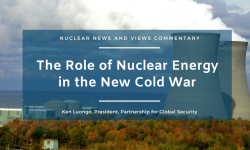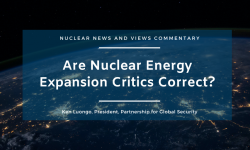A longer version of this article was published by The Center for the National Interest and it can be found here.
The nuclear energy policies of Washington and Seoul are caught in unprecedented political upheaval. President Trump’s tariff tear is creating international economic chaos. And the recent removal of Yoon Suk-Yeol as South Korea’s president is fueling the seemingly perpetual political churn in Seoul.
Both actions can undermine the ability to dominate the global nuclear energy market at home and abroad because the U.S. and Korean nuclear industries are deeply entwined.
A new presidential election in Korea must be held before June 3, and likely will result in the election of Lee Jae-myung, the leader of the Democratic Party. It’s energy policy is to reduce Korea’s reliance on nuclear power and focus on renewables backed by natural gas.
However, it may be difficult for Lee to completely backtrack on Yoon’s aggressive pro-nuclear goals. South Korea has endorsed the pledge to triple nuclear energy globally by 2050. It is moving forward with two new reactors at home. And Korea Hydro & Nuclear Power (KHNP) has been chosen to build two new reactors in the Czech Republic, estimated to be worth over $17 billion.
This is Korea’s first reactor export contract since 2009, when it won the United Arab Emirates (UAE) tender. The two countries worked well together on the Barakah nuclear project where Westinghouse was a major subcontractor, earning about $2 billion by providing components, engineering support, and project support. New Westinghouse reactors in Poland and Bulgaria will provide lucrative opportunities for Korean subcontractors.
This mutual dependency in reactor deployment has been the norm to date. But there is now the opportunity to move beyond this collaboration structure and forge a new nuclear cooperation construct based on opportunities emerging from the evolving international energy environment.
Saudi Arabia
Saudi Arabia has the potential to create a new dimension of U.S.-Korean nuclear cooperation in a third country. The U.S. was on track to complete a major strategic agreement with Israel and Saudi Arabia that included American support for the kingdom’s nascent nuclear power project, but it was torpedoed by the October 2023 Hamas attack on Israel.
Trump plans to make his first overseas trip to Saudi Arabia in May and that may be the springboard for a resurrection of the nuclear cooperation deal.
Energy Secretary, Chris Wright recently indicated that a U.S.-Saudi commercial nuclear power deal is possible, including a potential resolution of the sensitive issues “that involve [uranium] enrichment here in Saudi Arabia.” He noted that, “It’s critical that it becomes the United States as the partner,” to prevent Saudi nuclear dependence on Russia or China.
U.S. support for Saudi civil nuclear power would be prohibited without an agreement for nuclear cooperation between the two countries, which has never had a high probability of success for a variety of political and international security reasons.
However, Saudi officials positively viewed the UAE-Korea cooperation at Barakah, and a ROK lead in the kingdom’s nuclear project with U.S. subcontract support is possible. It would be politically and legally complicated because the Korean reactor still needs a U.S. export license based on its American components. But there could be a creative technical and political path forward if the 123 agreement negotiations fail.
AI Data Centers
A second opportunity is for Korea to cooperate with American firms as they build new reactors on U.S. soil. Major tech companies and states are jumping on the opportunity to deploy nuclear energy to power AI and its data centers.
If the demand for nuclear-powered data centers moves from concept to reality, there will be a growing need for engineering, procurement, and construction (EPC) support. This is an area where Korea and the United States could change the game on nuclear cooperation.
Korea is an efficient EPC nation, building the four reactors in the UAE essentially on time and within budget, and at a much lower unit cost than U.S. reactors. If U.S. reactors were to be built out for AI data centers, as well as other applications, there is a question of whether it would have enough EPC capacity.
This is where Korea and the United States could come to cooperate on U.S. soil in an unprecedented way. It would be more difficult with exotic-fueled advanced reactors, but probably doable if Westinghouse’s AP-1000, AP-300, NuScale’s VOYGR, or Holtec’s SMR-300 are shovel ready.
Innovative Financing
The third opportunity is for collaborative innovative finance for nuclear deployment.
The 2024 ADVANCE Act relaxes the previous legal ban on majority foreign ownership of U.S. nuclear facilities. This opens the opportunity for joint U.S.-Korean (and perhaps other allied nations) financing and control of these new reactors.
America has gone on a massive nuclear power spending spree over the last five years. Billions of dollars have been allocated to developing new reactors, creating the fuels that they run on, restarting shut-down reactors, keeping existing ones operating, and supporting U.S. reactor exports. But not as much is allocated to promoting reactor deployment.
The commercial financial markets remain hesitant to support nuclear deployment due to a number of obstacles, and neither the U.S. nor South Korea have committed the scale of sovereign capital to compete with Russian and Chinese state financing.
Both governments need to move beyond their current nuclear support systems and consider combining financing to limit risk.
The Korean nuclear industry is already substantially subsidized by the government. The U.S. seems to be keeping the Loan Programs Office alive for nuclear projects and the Department of Energy recently re-issued a $900 million solicitation focused on deploying Gen III+ and light water SMRs. It offers the biggest payout to “first movers” and “fast followers” to stimulate reactor deployment at scale. But the funding is not adequate for market gains.
This is where the U.S. and Korean governments could collaborate on a financing plan, creating an overarching political commitment to financially support nuclear deployment at a steady pace and then identifying the financing on a deal-by-deal basis.
These are examples of the dimensions of new nuclear cooperation that can pull American and Korean nuclear policy out of the current chaotic political undertow and advance their collective strength in nuclear deployment for the remainder of the century.
Ken Luongo, President, Partnership for Global Security





